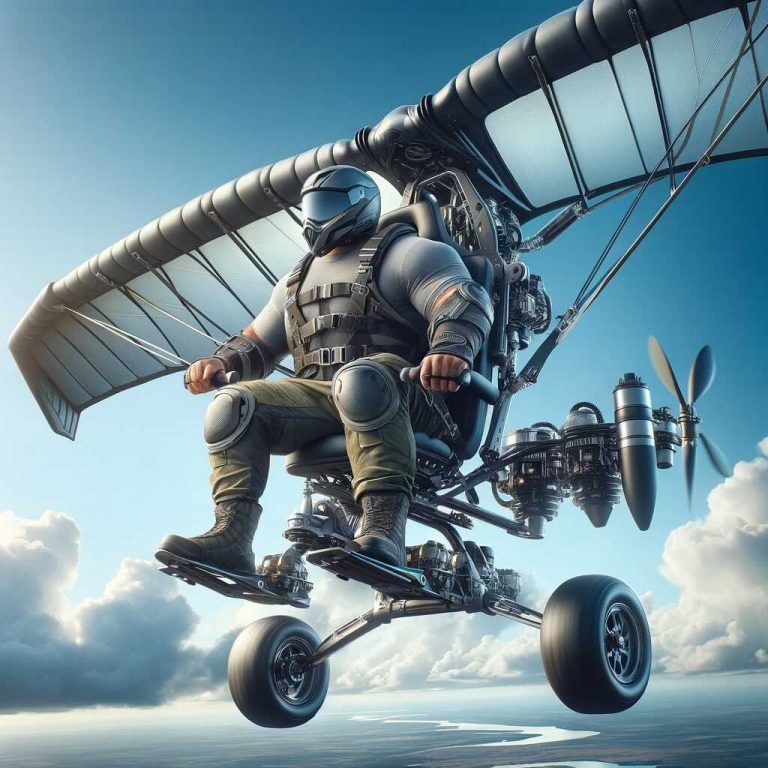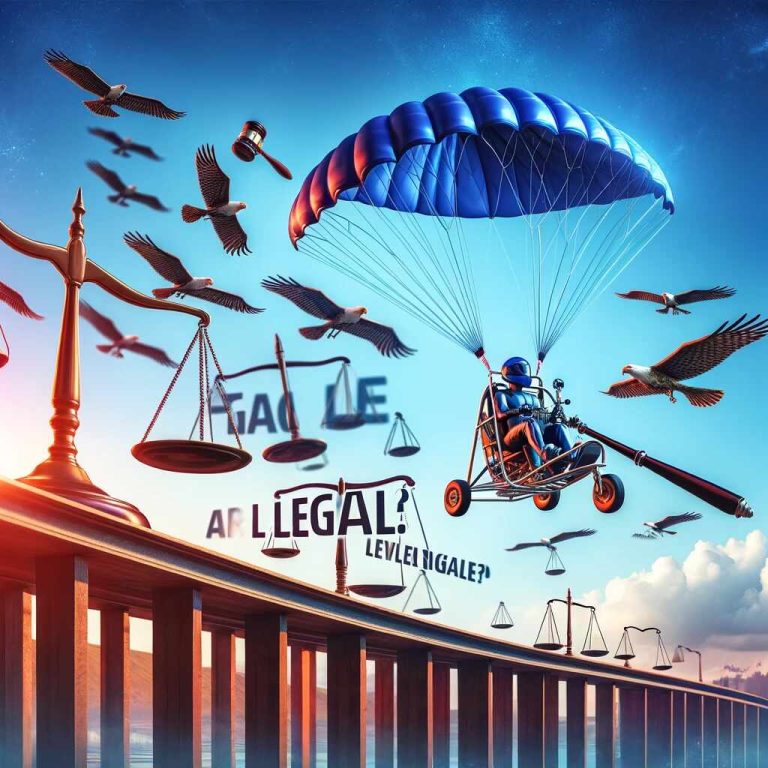Have you ever gazed up at the night sky and wondered if you could fly a paramotor through the darkness? The allure of night flying is undeniable, with the promise of serene moonlit landscapes and the thrill of experiencing the world from above in a whole new light (or lack thereof). However, before you strap on your paramotor and embark on a nighttime adventure, it’s crucial to understand the regulations, safety considerations, and legal boundaries that govern this exhilarating activity.
Can Paramotors Fly at Night?
Before you start preparing for a nocturnal paramotor adventure, it’s essential to address the crucial question: Can paramotors fly at night?
The straightforward answer is no; paramotors cannot legally be flown at night. This is a universal rule that applies to paramotor pilots worldwide. Flying a paramotor in the dark poses significant safety risks, not only to the pilot but also to other aircraft and people on the ground.
Understanding the Legal Restrictions
The legality of flying a paramotor at night is governed by aviation regulations in various countries. These regulations vary, but there are some common principles to consider:
1. Timing Restrictions
The timing for legal paramotor flights around sunset and sunrise can vary significantly based on your geographical location and the time of year. In some areas, like parts of Iceland during the summer months, the sun may not set at all, allowing for midnight flights. Conversely, during the winter, you may have a mere 4-hour window for daytime flights due to extended nights.
Generally, aviation laws stipulate that paramotor flights are permitted no sooner than 30 minutes before sunrise and no later than 30 minutes after sunset. These “twilight windows” are considered the permissible periods for paramotor operations. However, the precise timing can differ depending on your location and local regulations.
2. Equipment Requirements
To enhance visibility during twilight flights, many paramotor pilots opt to equip their aircraft with strobe lights. Strobe lights are crucial for making paramotors more visible to other aircraft in low-light conditions. The specific requirements for lighting equipment can vary by country, so it’s essential to check your local aviation regulations to ensure compliance.
For instance, in the United States, the Federal Aviation Regulation (FAR) 103 mandates that paramotors must be equipped with an operating anti-collision light visible for at least 3 statute miles when operating during twilight. Compliance with such regulations is vital for your safety and the safety of others in the airspace.
3. Special Permissions
While it’s generally illegal to fly a paramotor after sunset without proper lighting equipment, some pilots have ventured into the night sky with special permissions. These permissions are typically obtained from the relevant aviation authorities, such as the Civil Aviation Authority (CAA) in the UK.
Flying a paramotor in the dark under special permissions involves operating under Instrument Flight Rules (IFR). IFR requires the use of instruments for navigation and communication with air traffic control, making it substantially different from the Visual Flight Rules (VFR) that govern daytime paramotor flights.
The Risks of Nighttime Paramotor Flying
Flying a paramotor at night presents inherent risks that every pilot should be aware of. Safety is paramount in aviation, and ignoring these risks can have severe consequences. Here are some critical factors to consider:
1. Reduced Visibility
As daylight fades, visibility decreases significantly. Objects on the ground become harder to distinguish, making it challenging to spot obstacles, terrain features, or other aircraft. This reduced visibility can lead to accidents and collisions.
2. Depth Perception Challenges
Landing a paramotor in low light conditions can be particularly challenging due to impaired depth perception. Pilots may struggle to judge their altitude and distance from the ground accurately, increasing the risk of hard landings or crashes.
3. Increased Wind Variability
As the sun sets and the earth cools, wind conditions can become more unpredictable. Wind speed and direction may change rapidly, making it difficult to maintain control of your paramotor, especially for novice pilots.
4. Risk of Collision
Nighttime flights also pose a significant risk of mid-air collisions, as other aircraft may have difficulty spotting a paramotor without adequate lighting. The consequences of such collisions can be catastrophic.
Tips for Safe Twilight Paramotor Flights
If you have obtained special permissions and plan to embark on a twilight paramotor flight, it’s crucial to prioritize safety above all else. Here are some tips to ensure a safer nighttime flying experience:
1. Adjust Altitude Before Sunset
Keep in mind that the sun sets earlier at ground level than at higher altitudes. As sunset approaches, consider reducing your altitude to minimize the disparity in lighting conditions. This will help you stay closer to the ground and avoid sudden darkness at higher altitudes.
2. Practice Low-Light Landings
Landing a paramotor in low-light conditions can be challenging due to diminished depth perception. Gradually build your proficiency by practicing low-light landings during the twilight period. Start with landings just after sunset and gradually extend the time you spend flying in low-light conditions to improve your skills.
3. Equip a Strobe Light
Even if not legally required in your region, fitting a strobe light to your paramotor can significantly enhance your visibility to other aircraft. Strobe lights are invaluable for twilight and nighttime flights, increasing your safety by making you more visible to others in the sky.
4. Avoid Flying Low After Sunset
Maintaining a safe altitude during twilight and nighttime flights is essential. Avoid flying lower than 100 feet above ground level after sunset to reduce the risk of collision with obstacles or terrain features that may be challenging to see in low light.
5. Remove Sunglasses Before Landing
While sunglasses provide protection from the sun during daytime flights, they hinder visibility in low-light conditions. Always remember to remove your sunglasses before attempting a landing to ensure you have the clearest view of the ground.
The Importance of Adhering to Regulations
In summary, while the allure of flying a paramotor at night is undeniable, it is crucial to adhere to aviation regulations and prioritize safety above all else. Flying a paramotor after sunset without proper permissions and equipment is not only illegal but also jeopardizes the safety of yourself and others in the airspace.
Remember that special permissions to fly at night can be obtained, but these flights require a heightened level of preparedness, including the use of proper lighting and adherence to Instrument Flight Rules (IFR). Ignoring the rules and safety guidelines can lead to accidents, injuries, and even legal consequences.
As paramotor enthusiasts, it is our responsibility to respect the regulations that govern our sport. By doing so, we can continue to enjoy the freedom and exhilaration of paramotoring while ensuring its long-term sustainability and safety.
The Future of Paramotoring
As technology advances, the paramotoring community may see new developments in equipment and regulations related to nighttime flying. Innovations such as advanced lighting systems and instrumentation may open up new possibilities for safe and legal nighttime paramotor adventures.
However, until such advancements become commonplace and widely accepted, it is essential for paramotor pilots to remain informed about the current regulations and safety practices that govern their flights.
In conclusion, it is strongly recommended that paramotorists refrain from flying at night. The limited visibility at night poses significant safety risks, as you become difficult to spot by other aircraft, and your ability to discern the ground and identify suitable landing spots is greatly compromised in the darkness. Prioritizing safety by adhering to daytime flying regulations is essential for a secure and enjoyable paramotoring experience.
More Resources
For readers interested in further information about the regulations, safety considerations, and legal boundaries of flying paramotors at night, a variety of resources are available. You might start by checking with:
- National and Local Aviation Authorities: These organizations are the primary sources for the most current and specific regulations regarding paramotoring and other forms of ultralight aviation in your area. Examples include the Federal Aviation Administration (FAA) in the United States, the Civil Aviation Authority (CAA) in the UK, or similar bodies in other countries.
- Paramotoring Clubs and Communities: Local or national groups of paramotoring enthusiasts often have experienced pilots who can share insights and advice on flying, including the legal and safety aspects of night flying.
- Online Forums and Social Media Groups: Online communities can be a treasure trove of information where pilots from around the world share their experiences, tips, and occasionally, regulatory updates.
- Training Schools and Instructors: If you’re new to paramotoring or considering taking it up, a certified training school or instructor can provide comprehensive information on all aspects of flying, including what’s legal and safe.
- Aviation Safety Websites and Publications: These often have sections dedicated to ultralight aviation, including paramotors, and can offer detailed information on safe flying practices and legal considerations.
Remember, regulations and safety guidelines can vary greatly depending on your location and the specific conditions of your flight, so it’s crucial to consult the most relevant and up-to-date resources available to you.








